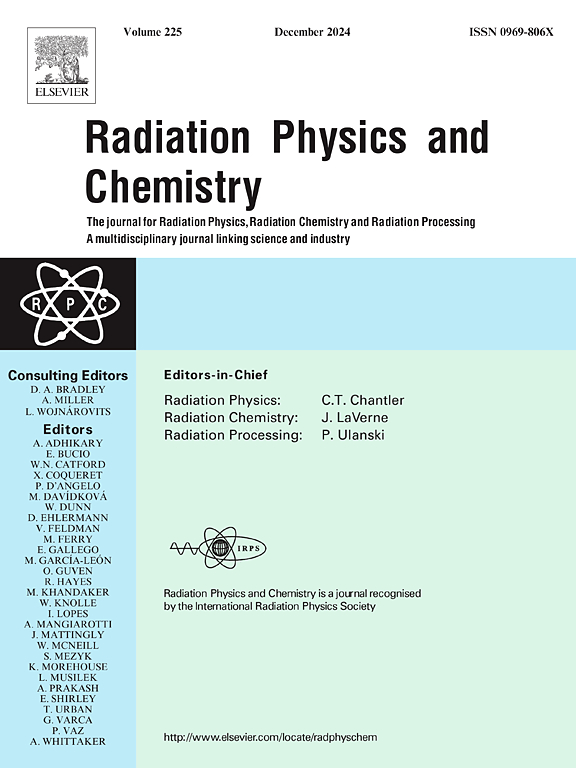基于神经网络方法的近阈值电子和正电子诱导原子内壳电离截面测量中的不适定反问题研究
IF 2.8
3区 物理与天体物理
Q3 CHEMISTRY, PHYSICAL
引用次数: 0
摘要
精确测量近阈值正电子或电子撞击原子内壳电离截面在理论和实际应用中都具有重要意义。由于薄靶制备复杂、厚度难以精确测量、正电子碰撞实验中薄靶特征x射线采集效率低等原因,通常采用厚靶法。用厚靶实验产率求解相应的内壳电离截面是一个不适定反问题。现有的方法如直接比较法、产量微分法、正则化法等,都不能达到理想的精度。虽然我们课题组最近开发了MC-neural network方法,显著提高了解的精度,但使用Monte Carlo模拟生成神经网络数据集非常耗时。为了解决这一问题,我们开发了一种数值-神经网络方法,该方法利用数值计算快速生成大规模、高质量的数据集,用于训练卷积神经网络模型来解决厚目标实验截面的逆问题。本文采用数值神经网络和mc -神经网络方法对能量低于10 keV的纯厚靶正电子碰撞中Ti和Ag的K β特征x射线和L βγ特征x射线的实验产额数据进行了处理。得到了Ti的正电子诱导k壳电离截面和Ag的L * βγ特征x射线产生截面,并与其他研究人员用直接比较法得到的实验截面和DWBA理论值进行了比较。结果表明,两种神经网络方法的解算结果与其他方法的解算结果和DWBA理论值吻合较好,数值-神经网络方法在解算精度上优于mc -神经网络方法。此外,本研究还对四川大学Li等人用厚靶法获得的能量低于27kev的电子诱导Zr的K * β特征x射线和Au的L * β特征x射线的实验产率数据进行了再处理。这也证实了数值神经网络方法比其他方法具有更多的优势。本文章由计算机程序翻译,如有差异,请以英文原文为准。
Investigation of the ill-posed inverse problem in measuring near-threshold electron and positron-induced atomic inner-shell ionization cross-sections based on neural network approaches
Accurate measurement of near-threshold positron or electron impact atomic inner-shell ionization cross-sections is of significant importance both theoretically and in practical applications. Due to the complexity of preparing thin targets, difficulty in precisely measuring their thickness, and the low characteristic X-ray collection efficiency of thin targets in positron collision experiments, the thick-target method is typically employed. Solving the corresponding inner-shell ionization cross-section from the experimental yield of thick targets is an ill-posed inverse problem. Existing methods such as the direct comparison method, yield differential method, and regularization method, do not achieve ideal accuracy. Although our research group has recently developed the MC-neural network method, which significantly improves solution accuracy, it is highly time-consuming to use Monte Carlo simulations to generate neural network datasets. To address this issue, we have developed a numerical-neural network method, which uses numerical calculations to quickly generate large-scale, high-quality datasets for training convolutional neural network models to solve the inverse problem of thick target experimental cross-sections. In this study, numerical-neural network and MC-neural network methods are used to process the experimental yield data of Kɑβ characteristic X-rays from Ti and Lɑβγ characteristic X-rays from Ag in positron collisions with pure thick targets at energies below 10 keV. The positron-induced K-shell ionization cross-section of Ti and the Lɑβγ characteristic X-ray production cross-section of Ag are obtained, which are compared with the experimental cross-sections obtained by the direct comparison method by other researchers and the DWBA theoretical values. The results show that the outcomes obtained by both neural network methods are in good agreement with the results from others and the DWBA theoretical values, and the numerical-neural network method is superior to the MC-neural network method in terms of solution accuracy. In addition, this study also reprocessed the experimental yield data of Kɑβ characteristic X-rays of Zr and Lɑβ characteristic X-rays of Au induced by electrons at energies below 27 keV, obtained by Li et al. of Sichuan University using the thick-target method. This also confirmed that the numerical-neural network method has more advantages than other methods.
求助全文
通过发布文献求助,成功后即可免费获取论文全文。
去求助
来源期刊

Radiation Physics and Chemistry
化学-核科学技术
CiteScore
5.60
自引率
17.20%
发文量
574
审稿时长
12 weeks
期刊介绍:
Radiation Physics and Chemistry is a multidisciplinary journal that provides a medium for publication of substantial and original papers, reviews, and short communications which focus on research and developments involving ionizing radiation in radiation physics, radiation chemistry and radiation processing.
The journal aims to publish papers with significance to an international audience, containing substantial novelty and scientific impact. The Editors reserve the rights to reject, with or without external review, papers that do not meet these criteria. This could include papers that are very similar to previous publications, only with changed target substrates, employed materials, analyzed sites and experimental methods, report results without presenting new insights and/or hypothesis testing, or do not focus on the radiation effects.
 求助内容:
求助内容: 应助结果提醒方式:
应助结果提醒方式:


